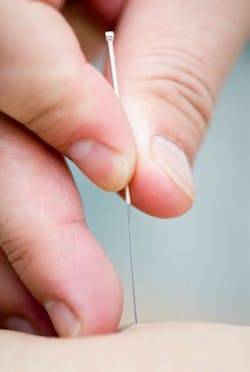What Is Dry Needling?
Dry needling is a form of therapy in which fine needles are inserted into myofascial trigger points (painful knots in muscles), tendons, ligaments, or near nerves in order to decrease pain and stimulate a healing response in painful musculoskeletal conditions. The term “dry needling” is used because the needle is not hollow, and no medication is injected (“wet needling”).
Is Dry Needling the same as Acupuncture?
Dry needling is NOT acupuncture. The needles may be the same, but the location, depth, technique, purpose, rationale, and methodology can all differ. Acupuncture is one aspect of Oriental Medicine, which differs from conventional “Western Medicine.” Acupuncture has the purpose of altering the flow of energy (“Qi”) along traditional, predetermined Chinese meridians, for the treatment of diseases. It can involve “pulse diagnosis” and “tongue diagnosis,” and can include burning the herb Mugwart over the needle (moxibustion). Acupuncture has been practiced possibly since prehistoric times and has taken on many forms depending on the country or time in which it was practiced.
Dry needling is a modern, science-based intervention for the treatment of pain and dysfunction in musculoskeletal conditions. There are a number of well-done studies that show Dry Needling is effective in conditions such as neck and low back pain, shoulder impingement, tennis elbow, carpal tunnel syndrome, headaches, knee / hip pain, shin splints, tendinopathy, and plantar fasciitis. Dry Needling is usually used in conjunction with other physical therapy tools and techniques such as therapeutic exercise, stretching, manual therapy (e.g., spinal, extremity and soft tissue mobilization), modalities (e.g., electric stimulation, heat/cold), and education.
What are the effects of Dry Needling?
- Decrease pain
- Increase blood flow
- Decrease inflammation
- Improve tissue healing
- Muscle relaxation
- Tissue restructuring
How does Dry Needling work?
Dry needling can work through a number of mechanisms. Simply put, the mechanical deformation caused by the needle insertion, manipulation, twisting, and stimulating causes chemical, electrical and physiological changes within the tissue (mechanotransduction).
For example, a “trigger point” is one type of condition for which dry needling can be used. These are certain sensitive and painful spots and / or bands in the muscle that can refer pain to other areas. Prolonged or unaccustomed exercise, mechanical trauma, prolonged tissue overload, stretch or muscle contraction (e.g., poor postures) can damage the cell membranes. This can lead to sodium and calcium imbalances, which can lead to spontaneous muscle contractions within small areas or bands within the muscle (spontaneous electrical activity, or SEA.) This contraction not only can prevent blood from bringing in nutrients and oxygen into the area, but also prevents the area from clearing chemicals that can cause pain (e.g., bradykinin, prostaglandins, serotonin, calcitonin, substance P, cytokinins) which build up and can cause an acidic environment creating further irritation, pain and inflammation. Also, now that the area gets less nutrients, but is more active than normal, there becomes an energy crisis, which further increases pain. As a result of all these changes, the tissue can actually shorten, which adds to further pain and dysfunction. Dry needling has been shown increase the blood flow and help normalize the tissue chemistry.
Dry Needling can also help by causing the production of your body’s own pain-relieving chemicals such as endorphins, enkephalins, serotonin, and acetylcholine. In addition, it can also stimulate specific types of nerve fibers which can cause the brain to block out pain impulses from the types of nerve fibers which transmit pain.
How painful is dry needling?
Dry needling is often met with some level of trepidation, especially for the first treatment. After all, it does involve needles. But these needles are very thin, not hollow, and nothing is injected through them. Many people do not even know when the needle has been inserted. With that said, most people feel the needle as it is being manipulated by the therapist. Some discomfort is thought to be beneficial, but it is usually short-lived. The therapist will work within your parameters and never cause more discomfort than you want to tolerate.
Is Dry Needling safe?
Drowsiness, tiredness or dizziness occurs after treatment in a small number of patients (1-3%) and if affected, you are advised not to drive. Minor bleeding or/bruising occurs after dry needling in 15-20% of treatments and is considered normal. Temporary pain during dry needling occurs in 60-70% of treatments. Existing symptoms can get worse after treatment (less than 3% of patients); however, this is not necessarily a “bad” sign. Fainting can occur in certain patients (0.3%), particularly at the first treatment session when needling the head or neck regions. Dry needling is very safe; however, serious side effects can occur in less than 1 per 10,000 (less than 0.01%) treatments. The most common serious side effect from dry needling is pneumothorax (lung collapse due to air inside the chest wall). The symptoms of dry needling-induced pneumothorax commonly do not occur until after the treatment session, sometimes taking several hours to develop. The signs and symptoms of a pneumothorax may include shortness of breath on exertion, increased breathing rate, chest pain, a dry cough, bluish discoloration of the skin, or excessive sweating. If such signs and / or symptoms occur, you should immediately contact your physical therapist or your physician. Nerves or blood vessels may be damaged from dry needling which can result in pain, numbness or tingling; however, this is a very rare event and is usually temporary. Damage to internal organs has been reported in the medical literature following needling; however, these are extremely rare events (1 in 20,000).
What training must a physical therapist have to perform Dry Needling?
Requirements vary by state. In Tennessee, physical therapists must be licensed and have been practicing for at least one year. They must go through at least 50 hours of additional state-approved training.
*This is a very simplistic explanation of a complex subject. Feel free to talk with your therapist to ask any questions or discuss any concerns you might have.

